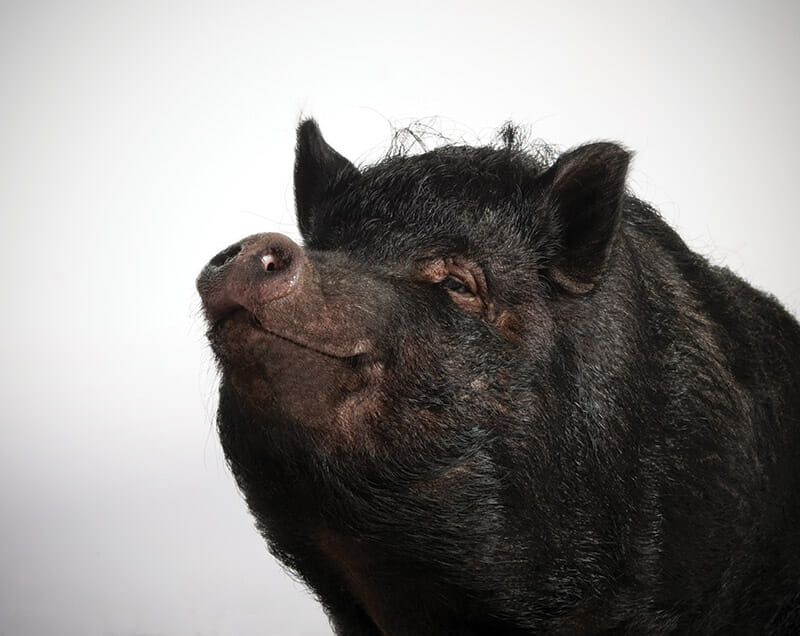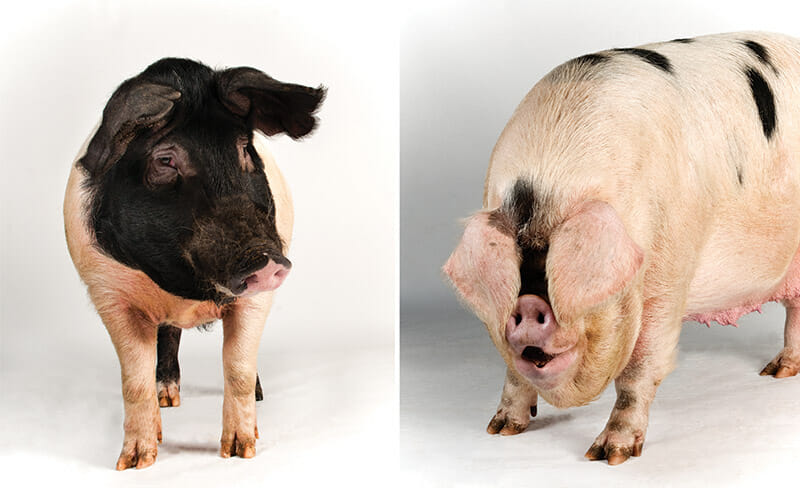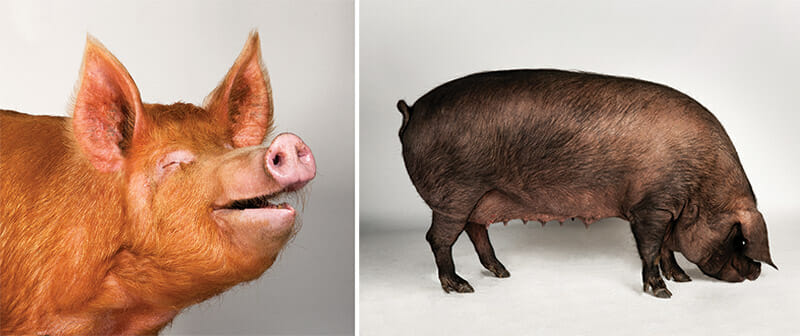Our guide to finding the perfect porcine pal, whether for companionship or lardo.

It’s important to know what you’re getting into, though. Pigs, says heritage breeder Jenny Blaney, can be “totally destructive. They can wreck 200 acres overnight, but they are gregarious, chatty, smart, a joy. God had a sense of humor when he made pigs, and you have to have a sense of humor when you own them.”
With a lifespan of at least 10 years, a pet pig is a big commitment. Outdoor pigs need a nice dry place to sleep, like a strawfilled shed or doghouse. Indoor pigs need comfortable, soft bedding – large crates or dog beds work well. As natural herd animals, pigs like company, so much so that pig owners report it’s often easier to keep two pigs than just one. And your pigs will need space to exercise. The major problems with pigs of all kinds, says Dr. John Carr, a veterinarian specializing in pigs, is that “the adults are generally overfed.” In other words, don’t let your porker become a porker.
Regardless of breed, feed your pigs specialized feed and supplement their diet with vegetarian kitchen scraps or produce from your yard. Read on for more tips on finding the right porcine pal for you.
[mf_h5 align=”left” transform=”uppercase”]Pets[/mf_h5]
Vietnamese Potbellied Pig
Hobby hog farmers will attest to the friendliness of pigs of all stripes (and spots), but Vietnamese potbellied pigs make the best indoor pets. In contrast to many full-sized hogs, which can tip the scales at 600 to 1,500 pounds, adult potbellieds average just 120 pounds – which is still plenty for an animal that’s smart enough to open the refrigerator door. Living with pet pigs will require childproofing your home, and potbellieds are a bit like toddlers: They are by turns snuggly, aggressive, intelligent and stubborn. While pigs and cats may become close friends and even bedmates, dogs are natural pig predators and therefore not generally compatible with potbellieds.
Kunekune
Potbellied-sized kunekune pet pigs are friendly and outgoing: “They are great backyard pets,” says Susan Armstrong-Magidson, president of the Pig Placement Network, which finds new homes for pet pigs. Unscrupulous dealers may advertise “micro-pigs” or “teacup pigs,” but these are simply piglets that will eventually outweigh a middle-school bully.
[mf_h5 align=”left” transform=”uppercase”]Food[/mf_h5]
Saddleback (left) and Gloucestershire Old Spots (right)
For generations, European truffle hunters have trained female pigs to seek out the prized wild fungi, whose scent resembles a sexual pheromone in male pigs. Once the search is complete, separating a sow from her truffle is a tricky business, so these days truffle dogs are more common. Any breed will do, but saddlebacks are known for their grazing ability, and Gloucestershire Old Spots are particularly adorable, with their lop ears suggesting an eye on the ground.
Tamworth and Large Black
Pigs raised for bacon are usually slaughtered at around 6 months old, if you can bear it. And in a bacon contest, Tamworth and Large Black pigs are usually the winners. Both grow relatively slowly, which produces fine-grained ribbons of fat laced into the meat of the belly. If you’re planning to raise pigs for bacon, be ready for the messy business of slaughter. If you’re wanting to sell your meat, or are feeling squeamish, find a USDA-certified slaughterhouse near you.
Berkshire (not pictured) and Oxford Sandy and Black
Berkshire pigs (often marketed as kurobuta) have gained a reputation for flavorful, marbled pork. Genetically related, both Oxford Sandy and Black and Berkshire pigs offer delectable pork and bacon, plus excellent temperaments, making them perfect for first timers interested in raising pigs for meat and company (though pigs raised for pork are also slaughtered around the 6-month mark).
[mf_editorial_break layout=”twocol” title=”Lardo With Asparagus” subtitle=”Recipe” textcolor=”#ffffff”]
Raising pigs offers many rewards, but making wildly flavorful lardo, or cured pork backfat, may be the greatest. For this simple cure, you’ll need cheesecloth, a nonreactive baking dish and string.
Ingredients:
1/2 pound kosher salt
8 tablespoons (4 oz) granulated sugar
2 tablespoons (1 oz) pink curing salt #13
1/2-pound skinless pork backfat, in a single slab
1 bunch (about 1 oz) fresh rosemary
1/4 cup black peppercorns
1 bunch asparagus
Extra-virgin olive oil
1. Combine kosher salt, sugar and curing salt. Coat the bottom of dish with 1/3 of cure mixture, place backfat on top and sprinkle in rest of cure. Arrange rosemary and peppercorns across backfat.
2. Cover tightly with plastic wrap, pressing down to eliminate access to air. Cover tightly again with aluminum foil. Weight pork down with plates and refrigerate. Keep refrigerated for about 2 weeks, flipping backfat every other day. The salt cure is complete when lardo feels firm and inflexible throughout.
3. Rinse in cool water and pat dry. Wrap in a double layer of cheesecloth and poke small hole in one corner. Loop string through hole and hang to dry in a cool (about 60 F), dark place for about 3 weeks.
4. Light spoils fat, so store lardo in plastic wrap covered with aluminum foil. To serve, lay asparagus on baking sheet and broil until it softens, about 5 minutes. Cover with very thin slices of lardo. Drizzle with olive oil to taste.
[/mf_editorial_break]
[mf_h5 align=”left” transform=”uppercase”]Behind the Scenes of Pork Photography[/mf_h5]
Photographer Richard Bailey takes us behind the scenes of shooting the cover model for our Spring 2014 issue — one very noisy pig named Tallulah.
[mf_video type=”vimeo” id=”88363570″]




do you have any recommendations of books about the care of pigs? in particular kune kune/miniture/micro pigs.
many thanks
You forgot Göttingen pigs! Which are the real mini-pigs… c’mon.
Not simply could it be being well thought of, but
the potential of being in a position to generate something which
will abandon folks in awe is quite vital.